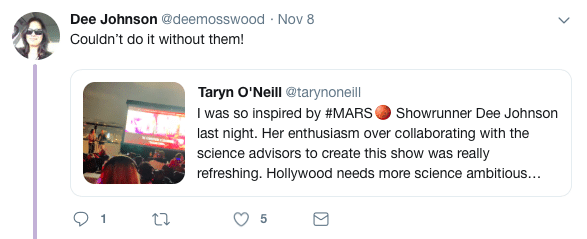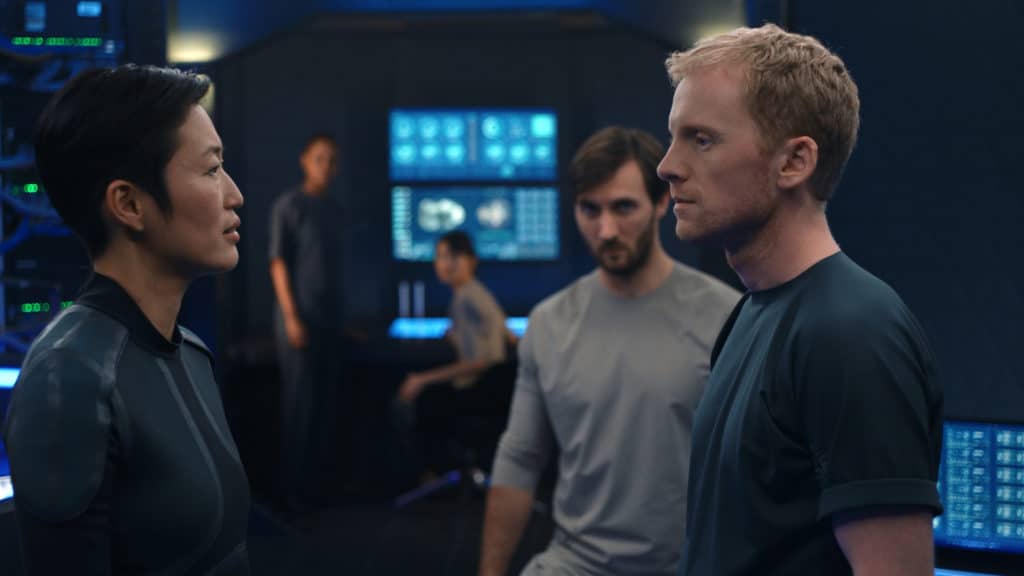Explore Earth’s fragile state at the hands of big corporation and fossil fuel driven governments with a slice of Sagan-esque hope and optimism via a trip to Mars.
National Geographic, Imagine Entertainment and RadicalMedia’s ambitious hybrid series Mars premieres its second season with increased drama on both Mars and Planet Earth. As our mission at Scirens is to champion science literacy in the general public, especially through the vehicle of entertainment. Mars hits the sweet spot: A fictionalized TV series about building the first settlement on Mars, framed by interviews and docu-segments of real life scientists, engineers, authors and activists (as Nat Geo calls them: ‘Big Thinkers’). It is Edu-tainment in fine form, although the unscripted segments highlighting real life climate activists often cast a more powerful spell.
Season One saw the IMSF (International Mars Science Foundation) team of scientists struggling to build the first settlement on the hostile Martian terrain, culminating in the discovery of microbial life. Season Two brings more conflict in human form when a multi-national mining corporation, Lukrum Industries, sends a team (headed on Earth by Caprica’s Esai Morales, and on Mars by Chicago Fire’s Jeff Hephner) to the red planet to begin mining expeditions.
The theme is clear: Science vs Big Industry. This plays out across the two narrative structures. On Mars, the two camps have clearly competing objectives, but they each need resources from the other to survive: Lukrum needs power and water for its camp and Olympus Town needs Lukrum solar panels to help with its terraforming endeavors, causing them to form a shaky alliance. As the corporate ‘villains’, the audience never quite feels the threat of Lukrum (and to the writers’ credit, they are not presented as traditional villains, merely an ambitious team doing their job). In the documentary sections, however, our activists and scientists are portrayed as David to Big Corporation’s Goliath. Activists are solo on their journeys, risking treacherous ice shelfs, solitary days at sea, jail time or worse… and fighting public backlash as they are reporting (climate) news people don’t want to hear. These people reveal the truly dire situation our planet is in and the seemingly insurmountable obstacles of the fossil fuel industry, an apathetic US government and the oil consumed Russian government. Scripted Mars is rife with drama, but nowhere near the high stakes that we see via the featured activists fighting to save Terra Firma.
Indeed, showrunner Dee Johnson had a challenging task. In a limited six episode season, it’s difficult to have audiences invest in characters when there is such a large ensemble to write for in half the traditional screen time. Plus, the time leaps forward between each episode are 2-3 months, dipping you in and out of the characters’ lives, and often only at times of peak drama. The documentary sections, though, have the benefit of focusing on the one main scientist or climate activist per episode, drawing you into their stories, especially those of Greenpeace activists Sini Saarela and Vladimir Cihuprov.
What was certainly compelling on the fictional Martian terrain was the continued development of the lead female characters: Olympus Town Commander (played by Jihae), chief medical officer (Clementine Poidatz), micro biologist (Anamaria Marinca) and head of the IMSF on Earth (Cosima Shaw). We are told most about them through their actions in the face of adversity and loss, as any good drama will do, but we often lack witnessing their lighter sides or their optimism. Happily, this was hinted at in the wonderful season finale, the strongest of the season, which brings the four women front and center amongst a catastrophic event on Mars that captures the global attention of Earth. I won’t divulge any spoilers but it is the mere action of our humans on Mars addressing a world wide audience and sharing their journey, that lands effectively and emotionally, connecting the two worlds and driving home why this mission is so important.
We love the ambitious science told throughout this series. We love how the writing team under Dee Johnson embraced collaborating with the science advisors:
We love the community of ‘Big Thinkers’ that Nat Geo has assembled both on camera and off to support the show. And most of all, we love that diverse females in STEM are front and center, both in front of the camera and writing it (but how about some females behind the camera, please?) The passion and purpose that Ron Howard radiated at the premiere for creating this brand of forward thinking, science driven storytelling was inspiring. It’s important to point out how expensive a show like this is to make and Mr. Howard’s appreciation of National Geographic taking the risk was clear. Only with heavyweights like them leading the charge will we get this sort of edu-tainment. But it is paramount.
Watch Season 2 of MARS on Mondays at 9PM, starting November 12th, on the National Geographic channel.



